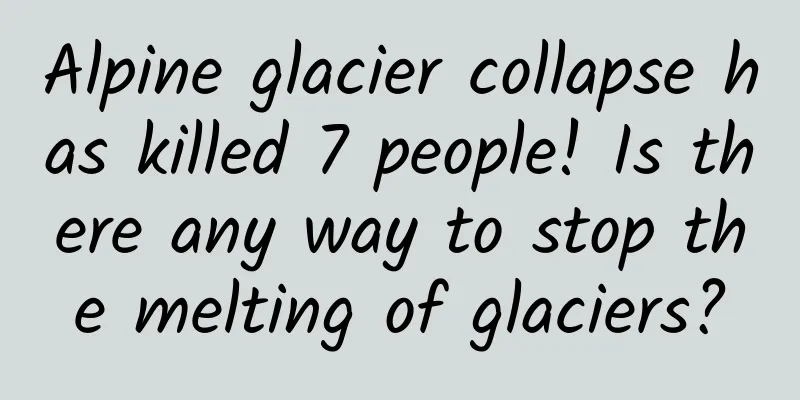Alpine glacier collapse has killed 7 people! Is there any way to stop the melting of glaciers?

|
On July 3, a high mountain glacier collapsed in the Marmolada Mountains in the Alps in northern Italy (hereinafter referred to as the "ice avalanche"), causing at least 7 deaths, many injuries and missing persons as of press time. Some experts pointed out that the cause of the accident may be related to the extremely high temperature weather in Italy in recent days. It is understood that the main peak of Mount Marmolada is 3,343 meters above sea level. In normal years, the temperature at the top of the mountain has been below zero degrees Celsius. However, recently the sea level temperature in the Veneto region where the mountain is located has reached 40 degrees Celsius, so the temperature at the top of the mountain has risen to around 10 degrees Celsius. So, what is the relationship between glacier melting and climate change? Which other glaciers are melting around the world? How can humans use technology to protect glaciers? The Marmolada Glacier is one of the most rapidly melting areas in the world. Glaciers are a product of climate and are very sensitive to climate change. Wang Feiteng, a researcher at the Northwest Institute of Eco-Environment and Resources of the Chinese Academy of Sciences, said in an interview with Science and Technology Daily that against the backdrop of global warming, most of the world's glaciers are in retreat. "In the past 20 years, the areas with the most intense glacier melting have appeared in the southern Andes, New Zealand, Alaska, central Europe and Iceland." Wang Feiteng told Science and Technology Daily that the Marmolada Glacier where the ice avalanche occurred is located in central Europe, which is one of the areas with the most intense glacier melting in the world. As climate warming intensifies and glaciers melt, glacier instability increases and disaster risks intensify. Common disasters include ice avalanches, glacier surges and glacial lake outbursts. Wang Feiteng further introduced that the occurrence of ice avalanches will induce a series of secondary disasters, forming a disaster chain, thereby prolonging and amplifying the consequences of disasters. For example, ice avalanches lead to landslides, moraine debris flows, glacial lake outbursts, floods, mudslides, etc. "The collapse of the Marmolada Glacier ice sheet formed a landslide mixed with ice, snow and rocks, which is a typical ice avalanche disaster," said Wang Feiteng. Does glacier melting accelerate climate change? Still lack of systematic research Currently, the melting of glaciers has had widespread and profound negative impacts on local, regional and even global social-ecological systems. A well-known early warning analysis is that if the Antarctic glaciers melt, some lowlands, coastal areas, and islands around the world will be submerged, and the economically developed coastal areas of most countries will also be seriously threatened. It may cause the coastline to retreat, destroying the ecological balance of near-shore mudflats, and disrupting the biological clocks of many marine organisms that reproduce in the nearshore. In fact, what needs more urgent attention at present is the comprehensive impact of glacier melting on the ice and snow tourism system, cold region animal husbandry system, arid region oasis agriculture system, cryosphere disaster-bearing area system, cold region major projects, coastal and island national security, polar habitat system, etc. "You know, glaciers contain 78% of the world's fresh water resources and play an important role in regulating the earth's temperature, global thermal balance and water balance." Wang Feiteng emphasized to Science and Technology Daily reporters that the glacier melting process involves many factors, including changes in albedo, the release and absorption of latent heat in the process of solid-liquid phase transition of glaciers, and the circulation of water and energy caused by changes in area. These factors will directly affect surface energy and water vapor flux, clouds, precipitation, atmospheric circulation and ocean currents. "There is currently a lack of systematic research to directly answer the scientific question of 'whether glacier melting will accelerate climate change'," said Wang Feiteng. Engineering measures such as "covering glaciers with blankets" have begun to be tested in China Currently, research on glaciers mainly focuses on the changing process, mechanism and prediction of future changes, while there is very little research on engineering measures to deal with glacier melting. Wang Feiteng told Science and Technology Daily that applying scientific methods to alleviate glacier melting and maintain sustainable use of water resources is particularly important in the current situation of rapid regional warming and rapid glacier retreat. The reporter learned that the majority of mountain glaciers in my country are "small glaciers" (with an area of less than 0.5 square kilometers), accounting for about 70% of the total number of glaciers in the country. The large number of small glaciers is particularly vulnerable to climate warming. Once the small glaciers melt completely, it will be difficult to reverse their eventual extinction without human intervention. The energy required for glacier melting mainly comes from the sun's shortwave radiation. The absorption of shortwave radiation by glaciers mainly depends on the albedo of the glacier surface. The greater the albedo, the less energy the glacier absorbs, and vice versa. Wang Feiteng said, "Increasing the albedo of the ice surface is an important means to slow down glacier melting. Most of the current glacier protection plans are based on this principle." In 2014, the Xinjiang Uygur Autonomous Region People's Government established the Tianshan Urumqi River Source No. 1 Glacier Protection Area. Herders who had been grazing here for generations moved out of the protection area. More than 9,800 acres of grassland were expropriated and covered with soil and planted with trees. Tourism activities were banned, factories and mines were permanently closed, and the ecological environment began to improve significantly. "Strengthening the protection of the ecological environment in glacier areas, including restricting grazing, road construction, and construction, can reduce the deposition of wind and dust on glaciers, increase the albedo of the ice surface, and reduce melting," said Wang Feiteng. In addition, for small glaciers with tourism economic value, the "covering blanket" method has a significant effect. Starting in 2020, Wang Feiteng's team began to conduct relevant research experiments on Dagu Glacier in Sichuan, Urumqi River Source No. 1 Glacier in Tianshan Mountains in Xinjiang, and Altai Mus Island Glacier. Team members found that the use of artificial snow in summer can effectively slow down the melting of glaciers, and covering glaciers with luminous insulation materials can also slow down the melting of glaciers. Source: Science and Technology Daily ◎ Science and Technology Daily reporter He Liang Editor: Wang Chengyue Review: Julie Final judge: Wang Yu |
>>: Facing this summer's flu, how to "know yourself and know the enemy" to avoid being infected
Recommend
What did the Internet giants do on April Fools' Day?
Editor’s Note: Although this year's April Foo...
These are the top 10 signs of Alzheimer's disease. The earlier you discover them, the better!
Alzheimer's disease , commonly known as "...
HTC's failure to adapt to local conditions and its fatal shortcomings
HTC was once the king of the Android camp. In Apr...
Implementing user-unaware background crash handling in Android
As the saying goes, if you want to have no bugs, ...
Loser turns into celebrity "Celebrity Landlord" TV full version experience
Previously, Lexian Technology's "Celebri...
Does your brain start to age at age 20? To slow down brain aging, just do this!
Author: Xu Jun, Chief Physician, Beijing Tiantan ...
Jobs didn't even write a PowerPoint presentation about the Apple car, but Cook tried to drive it on the highway
Jobs' father was a competent auto mechanic. A...
Only 4 steps are needed to increase the appeal of Tik Tok video ads!
In Tik Tok, you often see those popular video adv...
As an excellent operator, how can you perform real-time analysis?
With the increasing number of operational methods...
User Operations: 5 Steps to User Growth
I've been reading some books on growth recent...
7 steps to help you write a clear plan
I believe this phenomenon should be quite common ...
Two dimensions teach you how to spread high-quality content?
In an era where content is king, the value of hig...
"Is there anything that can't be discussed after the New Year?" These things can't be discussed!
The New Year is coming soon, and people often say...
Baidu bidding OCPC delivery optimization guide!
What I want to talk about today is search OCPC. I...
Easy learning: the role of IMP pointer in Runtime
You may have seen many friends introduce the conc...









